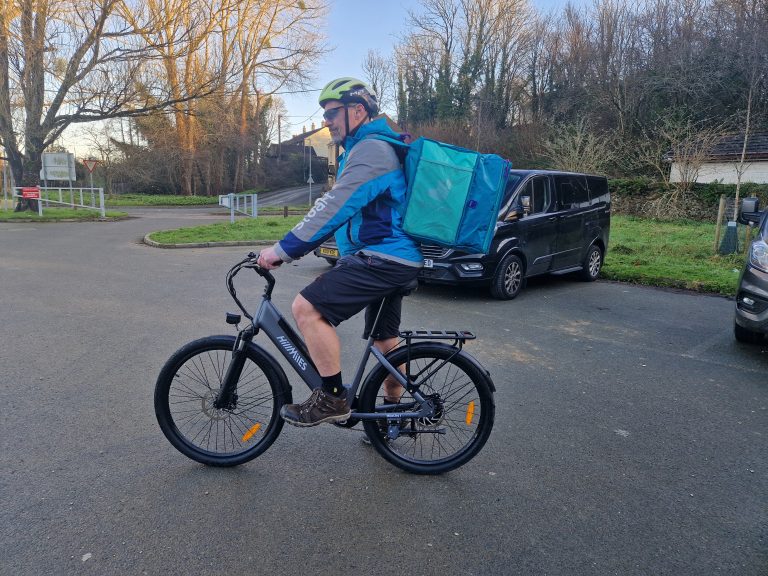E-Bike Battery Range Calculator
Estimate how far your e-bike can travel on a single charge.
One of the burning questions new e-bike riders often ask is, “How many miles can it go before the battery runs out?” The answer isn’t straightforward, as countless factors influence the range. Our e-bike battery range calculator provides an estimate based on common variables, but in reality, no two riders will achieve the exact same mileage on the same bike.
Riding style, fitness level, and effort all impact how much work the motor has to do. External factors like headwinds, air temperature, and terrain also play a role. For example, I can get 80-100 miles from a 540Wh mid-drive e-bike in eco mode thanks to years of cycling fitness, while another rider might only manage 40-50 miles. Similarly, a leisure rider cruising at a steady pace will use less battery power than a commuter battling a wet and windy morning in turbo mode.
Why E-Bike Range Varies So Much
E-bike manufacturers often advertise a maximum range, but real-world performance is influenced by multiple factors. While a large battery can help, range depends on a combination of power output, bike weight, riding conditions, and motor efficiency.
Key Factors Affecting E-Bike Range:
Battery Capacity (Wh): The battery’s watt-hour (Wh) rating is one of the biggest factors in determining range. A higher capacity (e.g., 500Wh vs. 250Wh) generally means more miles per charge, but efficiency varies based on other conditions.
Motor Power Output (W): E-bikes typically use motors ranging from 250W (the legal limit for UK road use) to 750W+ (off-road or unrestricted models). Higher-powered motors provide more torque and speed but consume battery power faster, especially when used at full assistance levels.
Motor Type – Hub vs. Mid-Drive: The type of motor fitted can heavily influence battery range. Hub motors (found in the front or rear wheel) are generally more affordable but tend to use more power, especially on hills. Mid-drive motors, positioned at the bike’s crankset, are more energy-efficient because they use the bike’s gearing to optimise power delivery, making them ideal for longer distances and hilly terrain. Mid-drive motors also provide a more natural riding feel and improve weight distribution.
Rider Weight & Cargo: A heavier rider or additional cargo (such as a backpack or delivery box) increases energy demand, meaning the motor has to work harder, reducing battery life. This is worth considering if you’re doing a delivery side hustle.
Assistance Level: Most e-bikes offer multiple assistance modes, such as Eco, Normal, and Turbo. Using Turbo mode constantly drains the battery much faster than riding in Eco mode with light pedal input.
Rider Fitness: A rider’s fitness level plays a significant role in e-bike range. The more effort you put in, the less load there is on the motor, resulting in better battery life. Experienced cyclists with good fitness levels naturally contribute more pedal power, reducing reliance on motor assistance, especially in lower assist modes like Eco. In contrast, less fit riders or those new to cycling may depend more on higher assist levels, draining the battery faster. Over time, as fitness improves, riders often find they can achieve greater range by using less assistance and maintaining a steady pedalling cadence.
Pedal Senor Type: Torque vs. Cadence: Torque sensors adjust motor output based on how hard you pedal, providing a smoother, more efficient ride and extending battery life. In contrast, cadence sensors simply detect pedal movement and activate the motor at a fixed level, often leading to inefficient power use, especially in stop-start conditions. E-bikes with torque sensors generally offer better range and a more natural riding experience.
Terrain & Gradient: Riding on flat roads consumes less energy than tackling hills. Steep inclines force the motor to draw more power, which can significantly reduce range. Headwinds also add resistance, further impacting efficiency.
Bike Weight & Tyre Size: Heavier e-bikes (such as fat-tyre models or cargo bikes) require more energy to move. Wider tyres increase rolling resistance, reducing efficiency, whereas thinner, high-pressure tyres roll more easily and extend range.
Tyre Pressure & Maintenance: Underinflated tyres increase rolling resistance, making the motor work harder and draining the battery faster. Regularly checking tyre pressure, lubricating the chain, and ensuring the brakes aren’t dragging can help optimise efficiency.
Battery Quality & Age: Not all batteries are created equal. High-quality lithium-ion cells (e.g., Panasonic, Samsung, LG) last longer and retain charge better than cheaper, unbranded alternatives. Over time, all batteries degrade, leading to reduced capacity and shorter range.
By considering these factors, you can maximise your e-bike’s efficiency, ensuring you get the best possible range for your riding style and conditions.

E-Bike Battery Range Myths
Myth 1: “Manufacturer range estimates are reliable.”
E-bike manufacturers often test battery range in near-perfect conditions—flat terrain, no wind, and a lightweight rider using the lowest power setting. In the real world, factors like hills, heavy cargo, stop-start traffic, and strong headwinds can reduce range by 30-50%. From experience, a good rule of thumb is to take the manufacturer’s claim and halve it—that way, you’ll have a much more realistic expectation of your e-bike’s true range.
Myth 2: “Pedalling without assistance drains the battery.”
Completely false! If you switch off the motor, your e-bike behaves like a regular bicycle. There’s no additional drag from the motor, though the extra weight of the battery and motor system means you’ll have to work a bit harder compared to a standard bike. Some cheaper e-bikes with lower-quality motors may have minor resistance, but for most modern models, pedalling without assistance won’t use any battery.
Myth 3: “All batteries are the same.”
While almost all modern e-bikes use lithium-ion batteries, their performance and lifespan vary significantly depending on the quality of the cells and the manufacturing process. Premium cells from brands like Panasonic, Samsung, and LG are designed for longevity, typically lasting over 1,000 charge cycles (equating to 3-5 years of regular use). In contrast, budget e-bikes often use lower-quality, unbranded cells—frequently from unknown manufacturers—which may degrade faster, reducing range and reliability over time.
Beyond the cells themselves, factors such as a well-designed Battery Management System (BMS), proper heat dissipation, and overall build quality also play a crucial role in battery efficiency and safety. Extreme temperatures—both hot and cold—can accelerate battery degradation, so storing and charging your e-bike in a stable environment will help extend its lifespan. If you’re investing in an e-bike for regular commuting or delivery work, paying attention to battery quality is just as important as motor power and frame design.
How to Maximise your E-Bike Battery Range
1. Optimise Your Riding Style
- Use Eco mode or switch off assistance on flat terrain to conserve power.
- Pedal smoothly and avoid sudden acceleration, which drains the battery faster.
- Maintain a steady speed—between 12-16 mph (20-25 km/h) is the most efficient for range.
2. Keep Your Bike Well-Maintained
- Check tyre pressure weekly, as underinflated tyres increase rolling resistance and waste energy.
- Keep the chain lubricated and drivetrain clean to reduce friction.
- Ensure brakes are properly adjusted—dragging brakes make the motor work harder and decrease range.
3. Plan for Terrain & Weather
- Hills consume more power—shift to a lower gear early to reduce motor strain.
- Headwinds increase resistance—adopt a more aerodynamic posture when possible.
- Colder conditions can reduce range by 10-15%—expect lower performance in winter.
4. Charge & Store Your Battery Correctly
- Charge regularly—leaving a lithium battery in a low state of charge for long periods can cause deep discharge, permanently damaging the cells.
- Keeping the battery at 40-60% charge when not in use for long periods helps preserve longevity.
- Charge at room temperature—charging in cold (below 5°C) or hot (above 40°C) conditions can degrade the battery faster.
- Don’t leave your battery fully discharged—recharge regularly rather than waiting until it’s empty.
By following these best practices, you can extend your e-bike’s range and battery lifespan, ensuring optimal performance for years to come.
How Our E-Bike Range Calculator Works
Unlike vague manufacturer estimates, our tool accounts for real-world variables:
Battery size (Watt-hours): The battery voltage multiplied by the Ah (ampere-hours) capacity.
Rider weight & cargo (kg/lbs): The combined weight of the rider, the bike and any extra cargo.
Terrain type (flat, hilly, mountainous): Self-explanatory
Assistance level (Eco, Normal, Turbo): Most e-bikes have between 3 and 9 levels of assistance.
Example: A 500Wh battery might give:
- 60 miles (100 km) in Eco mode on flat roads
- 30 miles (50 km) in Turbo mode on hilly terrain
Signs Your E-Bike Battery Needs Replacing
Like all lithium-ion batteries, e-bike batteries degrade over time, gradually losing capacity. If you notice a significant drop in range, such as only reaching 40 miles (60 km) when you previously managed 50 miles (80 km), it could be a sign of wear. Other indicators include noticeably longer charging times and sudden power drops while riding.
If your battery no longer holds a reliable charge, it may be time for a replacement. Most UK retailers stock compatible batteries, even for older e-bike models, but it’s worth checking compatibility and opting for high-quality cells from reputable brands to ensure longevity and performance.
Final Thoughts
Understanding your e-bike’s true range will help you plan longer rides confidently. Always take manufacturer estimates with a big pinch of salt, as real-world conditions will significantly reduce range. Understanding the influencing factors and following best practices can maximise your e-bike battery’s efficiency and longevity. Happy riding!
Got questions? Please leave a comment below!







